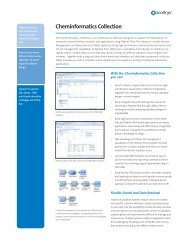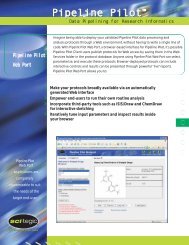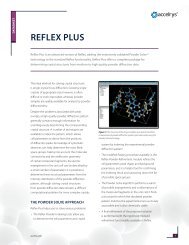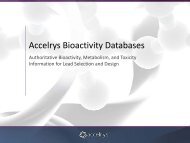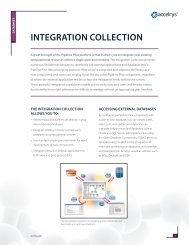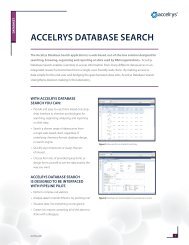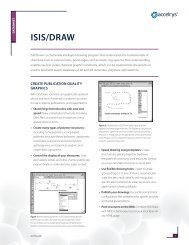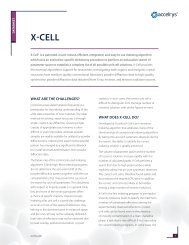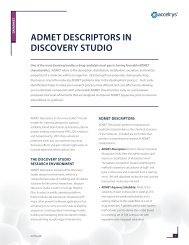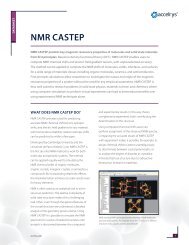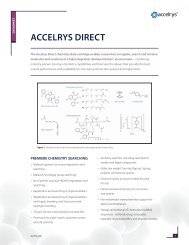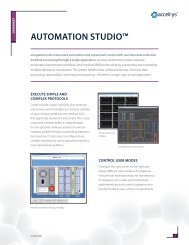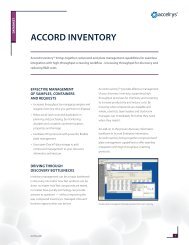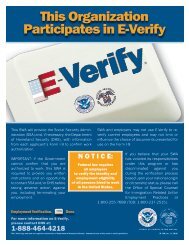X-AutofIt - Accelrys
X-AutofIt - Accelrys
X-AutofIt - Accelrys
Create successful ePaper yourself
Turn your PDF publications into a flip-book with our unique Google optimized e-Paper software.
path through the skeleton in a single pass. The second method 1<br />
is tailored for lower resolution maps (between 4.0 and 2.2 Å)<br />
and is based on the calculation and placement of vectors that<br />
represent the principle components of the secondary structural<br />
elements2 . These vectors are automatically converted into a Cα<br />
trace. X-AUTOFIT then takes these Cα traces and automatically<br />
extends them through the rest of the map. The end result is a<br />
close-to-complete trace of the structure. Semiautomated tools<br />
within X-AUTOFIT can then be used to extend the Cα trace into a<br />
complete structure. X-AUTOFIT also permits real space refinement<br />
of the Cα atoms with respect to the map.<br />
An additional option is available in X-AUTOFIT that automatically<br />
performs the low-resolution tracing protocol nine times with<br />
different starting parameters (bones sigma values). A ‘consensus<br />
trace’ is generated at the end of this process. This option saves<br />
time by automating a process that would otherwise have to be<br />
repeated manually, and it also ensures that the final trace is more<br />
likely to identify features in your low-resolution map that would<br />
otherwise have gone undetected in a single trace.<br />
Once a Cα trace is obtained, the sequence can be assigned to<br />
the trace with a single click (for high resolution maps). For low<br />
resolution maps, you are often able to identify characteristics of<br />
the amino acid side chain (e.g. large, medium, small, aromatic,<br />
or aliphatic). Using unique fuzzy descriptors, and any specific<br />
assignments, X-AUTOFIT quickly realigns against the protein<br />
sequence.<br />
Fully automated tools also exist for building an all-atom model<br />
of your structure, and to fit this model into the electron density<br />
using real-space refinement techniques. These steps used to take<br />
significant time and effort, and involved many interactive steps.<br />
But now, the entire process has been completely automated. The<br />
X-AUTOFIT application only requires an extended map. Although<br />
space group knowledge of the molecule under construction is<br />
highly recommended, it is not absolutely necessary.<br />
benefItS<br />
The availability of fully-automated tools means that you can<br />
quickly complete the de novo tracing of your structure. For<br />
high-resolution maps, the single pass tracing option is extremely<br />
accelrys.com<br />
DATASHEET: DiScovEry STuDio<br />
reliable and allows you to trace a majority of the Cα atoms in the<br />
structure with one click. For lowresolution maps, the automated<br />
tracing protocols enable you to arrive at a Cα trace within one<br />
minute. Furthermore, X-AUTOFIT can initially provide qualitative<br />
structural information when fitting Cα atoms into electron density.<br />
This can help you speed up the structure determination process<br />
in a number of ways, such as:<br />
• by providing you a good starting point in a map which has<br />
been difficult to trace<br />
• by providing a simple, fully-automated map fitting approach to<br />
accelerate the map fitting process<br />
• by helping you to diagnose whether a map is worth the effort<br />
of model building, or whether you just need better data<br />
Key feAtureS<br />
• Automatically generates a Cα trace from skeletonized electron<br />
density map utilizing built-in intelligence of protein structure<br />
features 3<br />
• Provides three tracing options uniquely suited for either low or<br />
high-resolution maps<br />
• Provides real space refinement of the Cα trace<br />
• Unique ‘knot analysis’ tool identifies incorrect tracing by<br />
checking for internal knots in the Cα trace<br />
• Automatically assigns the sequence to the Cα trace<br />
• For poor quality maps, quickly identifies unique fragments<br />
in the chain by using fuzzy descriptors for amino acids with<br />
forward and reverse automatic sequence alignment<br />
• Builds and refines a full coordinate representation of each<br />
Cα segment in seconds using one of four available methods,<br />
including a unique torsion angle real space refinement<br />
technique and a robust Cα correlation method<br />
2



